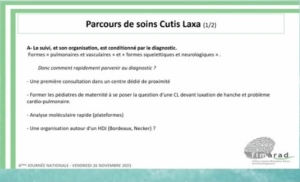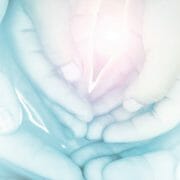Diagnosis Roving and Deadlock

The workgroup of FIMARAD (Rare Dermatologic Disorders French Network), of which Marie-Claude Boiteux is a member, is interested in Diagnosis Odyssey. An important piece of work for Cutis Laxa was presented during the FIMARAD meeting in November.
Due to the great diversity of types and symptoms, the quality of the healthcare journey for CL patients is intimately linked to diagnosis. So, it is not enough to diagnose a Cutis Laxa one needs to be really precise about which type of CL with the help of a molecular analysis (genetic testing).
The quality of the patient’s healthcare as well as the quality of their life depend on the swiftness of the molecular diagnosis. In France, a number of systematic tests are carried out immediately after birth to evaluate the newborn’s health (hernias, tone, mobility, hips,etc)..
A table has been created associating these systematic examinations with various CL symptoms to allow a faster clinical and molecular diagnosis. So, for instance, if the systematic examination of a newborn shows hip dysplasia, the next simple step is to see if the skin is lax and the newborn has hernias to suspect ARCL2A or Geroderma Osteodysplastica. The diagnosis can then be confirmed with a genetic test. Concordance of symptoms is the first step to a faster diagnosis.



